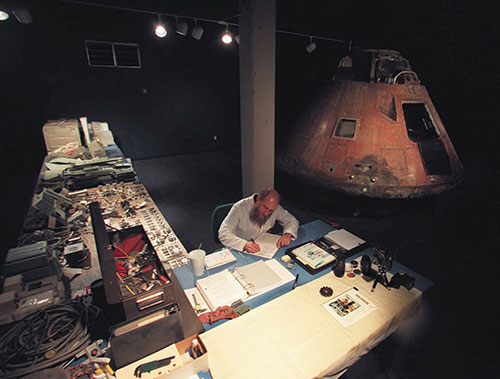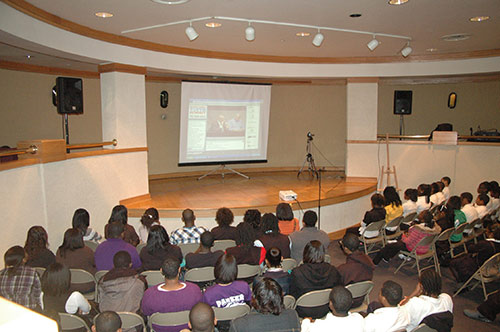Smithsonian Affiliations at 25: Chapter 5: Moving Forward, Together
Affiliations Anniversary Series: 25 Years in Your Neighborhood
Chapter 5: Moving Forward, Together
#SmithsonianAffiliations25

In 1996, the Smithsonian created this logo to celebrate its 150th anniversary.
In 1993, the Smithsonian’s Board of Regents established the Commission on the Future of the Smithsonian and tasked the group with “an examination of the Smithsonian, its mandate and its roles, and an examination of the cultural, societal, and technological factors that influence its capacity to act.” Two years later, the Commission issued a report that identified a range of strategies for the Smithsonian to consider as it approached its 150th birthday—strategies aimed at making the Institution more relevant and accessible to the American public and enabling it to fulfill its mission as a national organization.
The 1995 report concluded, “The Smithsonian cannot achieve the nation’s expectations by itself,” and set out a series of recommendations around education; collections, research, and exhibitions; governance; and the future. Embedded in this report were the following recommendations:
- Emphasize education both on the Mall and across the country through electronic means, traveling and collaborative exhibitions, and public programs,
- Build collaborative partnerships with other museums, research centers, and educational institutions throughout the nation, and
- Shape a master plan for maintenance of the priceless collections, including the sharing of collections through long-term or permanent loans to partner institutions.

As the Smithsonian’s 150th birthday celebration draws to a close, the crowd gathers in front of the Castle for an evening performance. Photo by Richard Hofmeister. Smithsonian Institution Archives, Acc. 09-257.
Just a year later, on the occasion of the Smithsonian’s 150th anniversary, I. Michael Heyman, then Secretary of the Smithsonian, announced the Smithsonian Affiliations program as one of several outreach initiatives introduced to fulfill the recommendations of the Commission and expand the Institution’s national reach: “The Smithsonian of the future must provide access to its collections and its vast resources. There is no value in being just the largest if we do not share the Smithsonian with as many people as possible. It means making sure those who cannot travel to Washington can somehow experience and enjoy the Smithsonian.”
In addition to the Affiliations program, the Smithsonian launched its first-ever website and the traveling exhibition, America’s Smithsonian, which featured some of the Institution’s most prized artifacts, including First Ladies’ gowns, Arthur Ashe’s tennis racquet, and the Apollo 14 command module, and reached an estimated 10 million people across the nation.
The Affiliations program was formally approved by the Board of Regents on September 15, 1996: “VOTED that the Board of Regents adopts the statement of policy and guidelines…on the Smithsonian Institution’s collections-based affiliations…”

Master restoration specialist Greg “Buck” Buckingham oversaw the evaluation, identification and reinstallation of more than 80,000 components of the Apollo 13 spacecraft Odyssey. This view shows Buckingham inside Odyssey’s restoration lab, which was glassed in to allow the public to view the historic project. Photo courtesy of the Cosmosphere, Hutchinson, KS.
The first Affiliate joined the program in early 1997. By the end of that year, there were 21 Affiliate collaborators across the U.S . As we entered the 21st century, more than 50 mission-aligned organizations made up the Affiliate network and were collaborating with the Smithsonian to bring its resources to their communities. In these first years, the Affiliations program was primarily envisioned as a way to extend the impact of the America’s Smithsonian exhibition and reach communities across the nation with objects from the Smithsonian’s collections. Affiliate organizations could borrow objects on long-term loan, connecting the Smithsonian with their audiences in ways that were meaningful, relevant, and accessible. Working with the National Air & Space Museum, the Cosmosphere in Hutchinson, KS began the restoration of the Apollo 13 Command Module Odyssey in 1995, as part of an effort to re-assemble the historic spacecraft. Made famous by the movie Apollo 13 which tells of the greatest rescue effort of a manned space flight, Odyssey went on display at the Cosmosphere in 1998, the same year the museum became an Affiliate. The command module remains on display today in the Cosmosphere’s Apollo Gallery, and the Affiliate continues to provide critical restoration services to the Smithsonian through its SpaceWorks division.
Over our 25-year history, Affiliations has grown far beyond its initial mandate to share objects with Affiliate organizations and has lived up to the Institution’s ambition to educate beyond the National Mall and build collaborative relationships with other museums and cultural organizations. Today, with more than 200 Affiliate collaborators in 46 states, Panama, and Puerto Rico, the Smithsonian is able to engage communities across the nation in myriad ways, many of which have been highlighted in our blog over the last several months. As a network, we are able to spark curiosity and learning, inspire a deeper understanding of our world, and work together to create a better tomorrow.
As the African proverb says, “If you want to go fast go alone. If you want to go far, go together.” As we at Smithsonian Affiliations celebrate our 25th anniversary, we look forward to many more years of moving forward together with our Affiliate collaborators and continuing the Smithsonian’s important work grounded in the increase and diffusion of knowledge.

Celebrate Smithsonian Affiliations’ 25th anniversary on social media with us September 15, 2021, #SmithsonianAffiliations25! All Smithsonian Affiliates are invited to share a memory as a Smithsonian Affiliate with us using the hashtag #SmithsonianAffiliations25. Make sure to tag @SIAffiliates on Twitter or @SmithsonianAffiliates on Instagram! Contact us for more info.
Catch up on our whole 25th Anniversary blog series here:
- Chapter 1: The Ten Thousand Springs Pavilion
- Chapter 2: National Youth Summits
- Chapter 3: Ten Years of Reaching for the Stars Together
- Chapter 4: Supporting the People Who Make Us Strong




